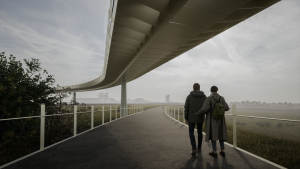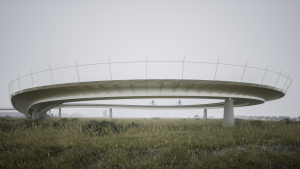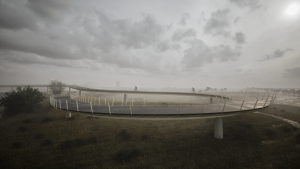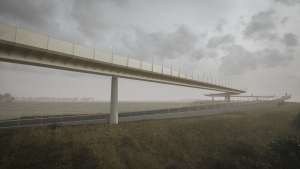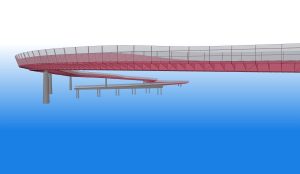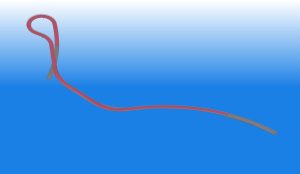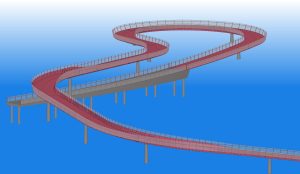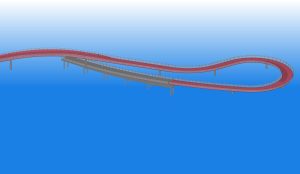Westelijke Ontsluitingsweg WOW

| Kategória | Infrastrukturális projektek |
|---|---|
| Év | 2023 |
| Ország | Benelux |
| Szervezet | SBE nv |
| Szerző | SBE |
| Ügyfél | Vlaamse Overheid |
| Az építmény helye | Havengebied Antwerpen |
| Tags |
Het project maakt deel uit van het projectbesluit Westelijke Ontsluitingsweg (WOW), onderdeel van het complex project ‘Realisatie van extra containerbehandelingscapaciteit in het havengebied Antwerpen’ (CP ECA), dit in opdracht van de Vlaamse Overheid (medegefinancierd door de Europese Unie).
Het project omvat de realisatie van de Westelijke Ontsluitingsweg, met bijhorende spoor- en fietsinfrastructuur en aanpalende buffering tussen havengebied en polder, inclusief de daarvoor vereiste compensatiemaatregelen (ter hoogte van Doelpolder Zuid).
In kader van de aanleg van het geplande tweede getijdendok is een primaire ontsluitingsweg noodzakelijk om een vlot vrachtwagenverkeer te verwezenlijken tussen het tweede getijdendok naar de hoofdwegen E34 en R2. De Westelijke Ontsluiting zorgt ook voor een noodzakelijke verbetering van de ontsluiting van de bestaande terreinen in de Waaslandhaven naar het hoofdverkeersnet. De ontsluiting zal ook functioneren indien de extra containercapaciteit of bijkomende logistieke terreinen niet worden ontwikkeld of een andere invulling krijgen.
Daarnaast is het vervolledigen van gewenste fietsverbindingen in de routenetwerken van de haven van belang. Dit ondersteunt de modal shift naar de fiets voor werknemers en het uitbouwen van een recreatief fietsnetwerk.
De Westelijke ontsluitingsweg is een primaire weg type II en moet, in combinatie met een geoptimaliseerde aansluiting aan de E34, zorgen voor een vlotte en veilige ontsluiting voor vracht- en autoverkeer van de toekomstige ECA ontwikkelingen-bouwstenen Tweede Getijdendok (2GD), Noordelijk Insteekdok (NID), binnenvaartkaai Doeldok (DD), Waaslandkanaal west (WLK) en Drie Dokken (3DK) naar het hoger wegennet (E34 en R2) waardoor vrachtverkeer niet in de dorpskernen komt. Daarnaast zorgt deze weg voor een vlotte en veilige ontsluiting van de bestaande bedrijven in de omgeving van het Deurganckdok, Doeldok, Verrebroekdok en Waaslandkanaal naar het hoger wegennet (E34 en R2).
Fietsbrug
Ter hoogte van de sporendriehoek wordt er een fietsbrug voorzien van 5,50m breed om de sporenbundels en westelijke ontsluitingsweg te kruisen (vrije hoogte boven spoor 6,00m) vertrekkend op 11 TAW tot 18 TAW (ruimte brugopbouw 1,00m). Deze bovengrondse kruising voorziet een functionele fietsroute tussen complex Hogendijk en complex Deurganckdok-West. Hiervoor worden er aanrijhellingen voorzien aan 3% helling met ook een rustbordes aan 1,5% (25m lang). Het tracé vat aan in het zuiden naast de nieuwe westelijke ontsluitingsweg om zo met een ruime bocht de infrastructuur te kruisen. Aan de noordzijde wordt er eveneens met een ruime bocht gedraaid langs het spoor heen om met een comfortabele bocht van R15 (binnenbocht) een lus-vormige beweging te maken en aan te sluiten op het fietspad langs de dijk. Dit tracé voldoet zo aan de normen van het huidige fietsvademecum.
De brug is opgebouwd uit een staalstructuur bestaande uit een koker met vinnen. De balustrade bestaat uit ranke stalen stijlen met een draadnet afgespannen als één gordijn. Er wordt een handgreep voorzien met geïntegreerde functionele verlichting. De balustrade laten we inclineren naar buiten toe in de bochten om het ruimtelijk gevoel en fietscomfort te maximaliseren.
De staalstructuren worden voorzien in zachte natuurlijke tinten (zand- en aardetinten). Dit ensemble geeft de brug een transparante aanblik, discreet geïntegreerd in het havenlandschap. De aanzet van de fietshellingen zijn voorzien in een betonnen U-bak (tot 2,00m hoog) afgewerkt in zichtbeton met houtnerfmotief (graffiti werend oppervlak). De stalen pijlers van de brug hebben een variabele overspanning gaande van 36 tot 43m.
Aanpak
Vanaf de start van het project hebben we gekozen voor een parametrische aanpak. Dit heeft als voordeel dat we gedurende de looptijd en verschillende fases van het project gemakkelijk verschillende varianten en tracés kunnen bepalen en modelleren. Zo kunnen we ook snel de invloed van een ontwerp zien (qua hoeveelheden, uitzicht, landelijke inpassing, …) alsook het aanpassen van de geometrie is hierdoor geen probleem. De brug is parametrisch ontworpen met behulp van de softwareprogramma’s Rhino & Grasshopper. Dit model is gekoppeld aan het rekenmodel van SOFiSTiK maar ook aan Tekla Structures, Revit en Civil 3D.
De ontworpen toestand, het tracé van de brug én het 3D alignement is getekend in Civil 3D. Deze data zijn gebruikt in Rhino en Grasshopper om hierrond de andere geometrie op te bouwen. Deze geometrie en data is hierna gebruikt in het rekenmodel in SOFiSTiK, maar ook in Tekla om de stalen brug en bekisting te genereren.
Door dit project volledig in 3D uit te werken en het gebruiken van de geschikte data, is het vanaf de start heel eenvoudig geweest om hoeveelheden aan materiaal op te vragen. Het stelt ons ook in staat om deze modellen te gebruiken als bron voor onze visualisaties, die tevens de basis zijn voor ons coördinatie-model. Tijdens het hele ontwerp stond werken volgens de BIM-methodiek centraal. Hergebruik van modellen en data, centrale bron van informatie & communicatie, dit zijn de essentiële zaken die dit project gesteund hebben.
The project is part of the Westelijke OntsluitingsWeg (WOW), part of the complex project ‘Realisatie van extra containerbehandelingscapaciteit in het havengebied Antwerpen’ (CP ECA), commissioned by the Flemish Government (co-financed by the European Union).
The project includes the realization of the Westelijke Ontsluitingsweg, with associated rail and cycling infrastructure and adjacent buffering between port area and polder, including the required compensation measures (at Doelpolder South).
As part of the construction of the planned second tidal dock, a primary access road is necessary to achieve fluent truck traffic between the second tidal dock and the main E34 and R2 roads. The Westelijke Ontsluiting also provides a necessary improvement in the accessibility of the existing sites in the Waaslandhaven to the main traffic network. The access will function even if the additional container capacity or additional logistics sites are not developed or are redeveloped.
In addition, the completion of desirable bicycle connections in the port’s route networks is important. This supports modal shift to cycling for employees and the development of a recreational cycling network. The Westelijke Ontsluitingsweg is a primary road type II and, in combination with an optimized connection to the E34, should provide fluent and safe access for freight and car traffic to the future ECA developments-buildings Tweede Getijdendok (2GD), Noordelijk Insteekdok (NID), binnenvaartkaai Doeldok (DD), Waaslandkanaal west (WLK) and Drie Dokken (3DK)-to the higher road network (E34 and R2), preventing freight traffic from entering the center of villages. In addition, this road provides fluent and safe access to the existing businesses in the vicinity of Deurganckdok, Doeldok, Verrebroekdok and Waaslandkanaal to the higher road network (E34 and R2).
Bicycle bridge
At the level of the railway triangle, a bicycle bridge from 5.50m wide will be provided to cross the railway trusses and the Westelijke Ontsluitingsweg (clearance height above track 6.00m) starting at 11 TAW to 18 TAW (bridge structure height 1.00m). This above-ground crossing provides a functional cycle route between complex Hogendijk and complex Deurganckdok-West. For this purpose, approach ramps are provided with a 3% slope and a rest platform at 1.5% (25m long). The route will start in the south next to the new Westelijke Ontsluitingsweg to cross the infrastructure with a wide curve. On the north side, it also turns with a wide curve along the railway line to make a loop with a comfortable R15 curve (inside bend) and connect to the cycle path along the embankment. This route thus complies with the standards of the current bicycle vademecum.
The bridge consists of a steel structure composed of a rectangular section with fins. The railing consists of slender steel posts with a wire mesh stretched as a single curtain. A handrail is provided with integrated functional lighting. We let the balustrade incline outwards in the curves to maximize the spatial feeling and cycling comfort.
The steel structures are foreseen in soft natural tones (sand and earth tones), this design gives the bridge a transparent appearance, discreetly integrated into the harbour landscape. The start of the bicycle ramps is provided by a concrete U-shape (up to 2.00m high) finished in exposed concrete with a wood grain motif (graffiti-resistant surface). The steel piers of the bridge have a variable span ranging from 36 to 43m.
Approach
From the start of the project, we decided to go for a parametric approach. This has the advantage that we can easily determine and model different variants and trajectories during the design and different phases of the project. This way, we can also quickly see the impact of a design (in terms of quantities, appearance, integration, etc.) as well as adjusting the geometry. The bridge was designed parametrically using the software programs Rhino & Grasshopper. This model is linked to the SOFiSTiK calculation model but also to Tekla Structures, Revit and Civil 3D.
The designed situation, the alignment and profile of the bridge were drawn in Civil 3D. This data was used in Rhino and Grasshopper to build the other geometry around it. This geometry and data were used in the calculation model in SOFiSTiK, but also in Tekla to generate the steel bridge and formwork.
By modelling in 3D and using the appropriate data, it is very easy to get quantities of material from the start of the project. It also allows us to use these models as a source for our visualizations and these are also used in our coordination model. Working according to the BIM methodology was key throughout the design. Reuse of models and data, central source of information & communication is essential in this project.
